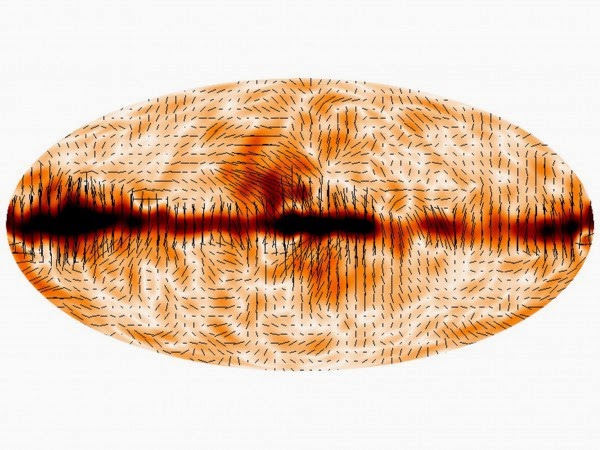
THE LEADING scientific theory of how the universe evolved has again proved accurate—for some, frustratingly so. The latest study of the afterglow of the big bang—the so-called cosmic microwave background (CMB) radiation—confirms even more precisely the standard model of cosmology, researchers with Europe’s Planck spacecraft reported today at a press conference in Ferrara, Italy. That’s a victory for the theory, but it leaves researchers with no discrepancies that might point to a deeper understanding.
“I was hoping to find an anomaly,” says Nazzareno Mandolesi, a cosmologist with Italy’s National Institute for Astrophysics in Bologna who described the new results at the press conference.
The CMB is radiation that has streamed through the universe since the first atoms formed about 380,000 years after the big bang. Thanks to the expansion of the universe, that radiation has cooled and stretched to microwave wavelengths.
The temperature of the microwaves varies very slightly across the sky, as does their polarization. By studying those tiny variations, the distribution of galaxies, and other factors, cosmologists have pieced together a recipe for the universe: 5% ordinary matter, the material that forms stars and planets; 27% dark matter, the mysterious stuff whose gravity holds the galaxies together; and 68% bizarre space-stretching dark energy.
Launched in 2009, Planck scrutinized the CMB until October 2013. In March 2013, Planck researchers presented the analysis of their first year’s worth of temperature data, which exquisitely confirmed the predictions of the standard theory of cosmology.
Still, there were uncertainties in the measurements and slight tensions with the results from Planck’s less precise predecessor, NASA’s Wilkinson Microwave Anisotropy Probe (WMAP), a spacecraft that collected data from 2001 to 2010. Now, the Planck team has analyzed its full data set, and the uncertainties have come down and the tensions with the WMAP results have eased, Mandolesi says.
For example, WMAP and Planck had disagreed by about 1% to 1.5% on their absolute temperature measurements, Mandolesi explains. A recalibration reduces the mismatch to less than 0.3%, within the statistical uncertainties, he says.
Regarding the parameters of the cosmological theory, Planck researchers derived a slightly longer age and a slightly smaller current expansion rate for the universe than WMAP showed, Mandolesi says. But with more data, the numbers have shifted slightly and now agree to within the experimental uncertainties, he says.
The findings aren’t all more of the same, says David Spergel, a cosmologist at Princeton University who does not work on Planck. The new results include maps of the CMB’s polarization (as seen in the image above), and that polarization data put limits on some explanations of what dark matter might be, Spergel notes.
In particular, Planck rules out certain models in which dark matter particles might annihilate one another at particularly high rates. Such models were invented to explain an excess of high positrons seen by detectors such as the Alpha Magnetic Spectrometer aboard the International Space Station.
The results do not touch on the most controversial claim in cosmology in decades. In March, researchers working with BICEP2, a specialized telescope at the South Pole, reported that they had detected faint, pinwheel-like swirls in the polarization of the CMB when mapped across a small patch of sky.
Such swirls, or B modes, could be a sign of gravitational waves rippling through the universe a split second after the big bang and proof that it underwent a bizarre exponential growth spurt known as inflation. However, in September Planck researchers released a sky map that showed that much of the BICEP signal likely comes from dust within our galaxy.
Many people are eager to know whether the BICEP team’s claim of spotting B modes will survive the joint analysis with the Planck team. “We’ve advanced a lot with the work, and we’re writing up the paper,” says Jan Tauber, a Planck project scientist with the European Space Agency in Noordwijk, the Netherlands. Tauber declined to say when the results of that analysis would be announced publicly. “What you can say with certainty is that [the strength] of their measurement is going to go down,” he says.
To determine how much of the BICEP signal is due to dust, researchers have to compare or “cross-correlate” BICEP’s map of the patch of the sky with Planck’s map of the polarized emissions from dust. Some researchers outside the two teams have already tried to do that and have shown that the two maps are largely the same, says Uroš Seljak, a cosmologist at the University of California, Berkeley. That suggests the purported signal is mostly from dust. Planck by itself likely does not have the sensitivity to detect gravitational waves, Seljak says.
Some cosmologists suspect that the BICEP signal will disappear altogether and that the joint Planck-BICEP analysis will set only an upper limit on the strength of the B-mode signal. Such a limit could rule out certain simple theoretical models of what drove inflation, Spergel says: “That’s not as much fun as discovering gravitational waves, but it’s progress.”(By Adrian Cho)
Link:http://news.sciencemag.org/physics/2014/12/study-big-bang-s-afterglow-sheds-light-evolution-universe
